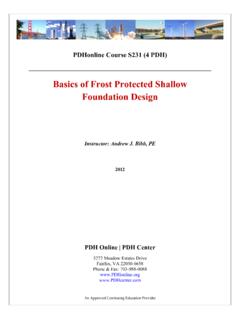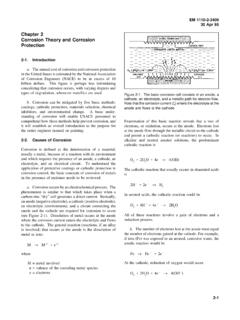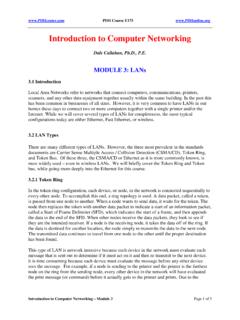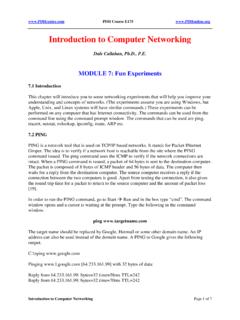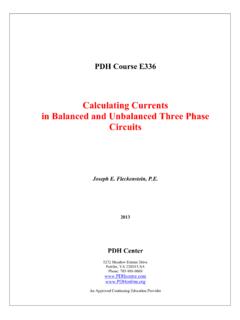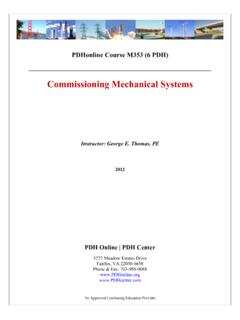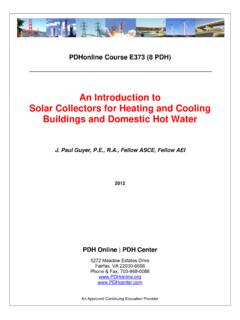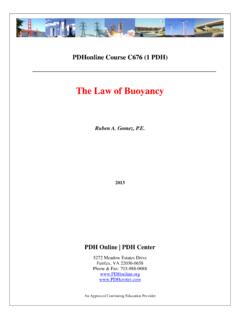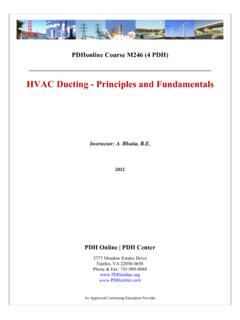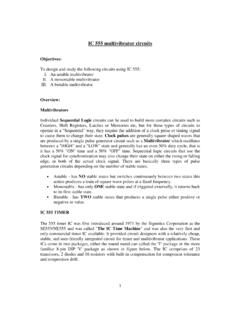Transcription of Substation Design Volume II - PDHonline.com
1 An Approved Continuing Education Provider PDHonline Course E469 (4 PDH) Substation Design Volume II Physical Layout Instructor: Lee Layton, 2015 PDH Online | PDH Center 5272 Meadow Estates Drive Fairfax, VA 22030-6658 Phone & Fax: 703-988-0088 PDHonline Course E469 Lee Layton. Page 2 of 50 Substation Design Volume II Physical Layout Table of Contents Section Page Preface .. 3 Chapter 1, Layout Considerations .. 4 Chapter 2, Typical Bus Configurations .. 16 Chapter 3, Insulation Protection .. 33 Chapter 4, Substation Insulators .. 39 Chapter 5, Electrical Clearances .. 46 Summary .. 50 This series of courses are based on the Design Guide for Rural substations , published by the Rural Utilities Service of the United States Department of Agriculture, RUS Bulletin 1724E-300, June 2001.
2 PDHonline Course E469 Lee Layton. Page 3 of 50 Preface This course is one of a series of thirteen courses on the Design of electrical substations . The courses do not necessarily have to be taken in order and, for the most part, are stand-alone courses. The following is a brief description of each course. Volume I, Design Parameters. Covers the general Design considerations, documents and drawings related to designing a Substation . Volume II, Physical Layout. Covers the layout considerations, bus configurations, and electrical clearances. Volume III, Conductors and Bus Design . Covers bare conductors, rigid and strain bus Design . Volume IV, Power Transformers. Covers the application and relevant specifications related to power transformers and mobile transformers.
3 Volume V, Circuit Interrupting Devices. Covers the specifications and application of power circuit breakers, metal-clad switchgear and electronic reclosers. Volume VI, Voltage Regulators and Capacitors. Covers the general operation and specification of voltage regulators and capacitors. Volume VII, Other Major Equipment. Covers switch, arrestor, and instrument transformer specification and application. Volume VIII, Site and Foundation Design . Covers general issues related to site Design , foundation Design and control house Design . Volume IX, Substation Structures. Covers the Design of bus support structures and connectors. Volume X, Grounding. Covers the Design of the ground grid for safety and proper operation. Volume XI, Protective Relaying. Covers relay types, schemes, and instrumentation. Volume XII, Auxiliary Systems. Covers AC & DC systems, automation, and communications.
4 Volume XIII, Insulated Cable and Raceways. Covers the specifications and application of electrical cable. PDHonline Course E469 Lee Layton. Page 4 of 50 Chapter 1 Layout Considerations This chapter presents general information concerning the Design of the Substation physical arrangement. It describes various types of substations , illustrates typical layouts, and presents guidelines to be used during detailed Design . Information concerning insulation and electrical clearances are reviewed in the following chapters. A careful analysis of basic parameters establishing the purposes and Design criteria for the Substation has to precede the detailed Design . In addition, circuit quantities, configurations, and ratings; system and equipment protective relay schemes; the necessity for specialized equipment details of surge protection equipment; and requirements for direct stroke protection should be considered.
5 The power system as a whole has to be considered when deciding the Substation switching scheme. Future system growth based on long-range forecasts may indicate the necessity for an economical, basic arrangement initially with possible future conversion to a more sophisticated scheme as the number of circuits increases. Important circuits may require additional protection or redundant supply. Equipment maintenance requirements may necessitate bypassing facilities to enable circuit operation during maintenance periods. Since the equipment that can be out of service for maintenance or during faults without sacrificing system operation depends on alternative supplies and duplication of circuits, the flexibility of the switching scheme is often one of the most important selection criteria. Large substations with many circuits handling great amounts of power need to have high degrees of both flexibility and reliability to continue service without interruption during the most undesirable conditions.
6 Since flexibility and reliability are directly proportional to cost, the ultimate configuration has to be the result of a compromise. Frequently, after initial Substation construction, requirements change, and plans for the ultimate capabilities of the Substation are altered. As a result, expansion of the Substation facilities may deviate from the anticipated initial plan. To accommodate unforeseen future system modifications, consider the flexibility of the arrangement. Since a typical Substation can be expected to continue in service indefinitely, maintaining maximum flexibility throughout each stage of expansion will ensure the least costly and most efficient use of the facilities during the service period. To facilitate future expansion, the initial Design should be arranged to accommodate long range needs. The site should be as large as practical to allow for future development.
7 Large areas readily allow for changes in the basic Substation configuration and switching scheme should future conditions so dictate. Leave at least one and preferably both ends of all major buses open or future expansion. When a basic initial arrangement is planned, placement of equipment should PDHonline Course E469 Lee Layton. Page 5 of 50 take into account future expansion of the Substation into a more complex, reliable, and flexible configuration. Frequently, additional switches, switch stands, and bus supports are installed initially to facilitate future expansion. The profile of Substation structures and equipment has become an increasingly important aspect to consider in Substation layout. In the past, large lattice and box-type structures supporting overhead strain buses were commonly used.
8 Most substations currently being designed and constructed use low-profile structures and rigid buswork, particularly for low-voltage distribution substations or in areas with natural environmental screening. Low-profile construction generally uses lower structures with a minimum number of members for support. Larger pieces of equipment, such as power transformers and power circuit breakers, have become smaller over the years. Consequently, substations are considered less obtrusive overall. The height limitations causing the use of low-profile construction sometimes result in arrangements of increased area, particularly for the lower voltage levels. Generally, the advantages of easier equipment operation and maintenance as a result of reduced equipment sizes and effective locations make up for the expense of purchasing somewhat larger sites. An effective method to improve Substation appearance is to install circuits underground as they leave the Substation .
9 Low-profile construction using lower structures with fewer support members lends itself to the use of underground circuits. Installing underground circuits can similarly improve the appearance of substations with larger structures by reducing the size of some of the large supporting structures or eliminating them altogether. Substation arrangements have to include adequate space for the installation and possible removal of large pieces of equipment such as power transformers and power circuit breakers. Buses, particularly in low-profile arrangements, even when at acceptable operating elevations, can block the removal of equipment. Consequently, it is important to consider equipment removal routes during the structure layout. Often the most desirable arrangement has the main buses at higher elevations than the buses and equipment in the Substation bays.
10 In this way, the main buses will not block the removal of equipment located in the Substation interior. Removable bus sections can also be provided to permit movement of large equipment. This, however, requires bus de-energization during the procedure. Bay spacing has to be carefully evaluated during layout to allow for removal of equipment. In multi-bay configurations, it is common to limit the number of bays to two before increasing the bay center-to-center spacing. This allows equipment to be removed from a bay to the side and provides additional space for moving the equipment between a bay and an adjacent bay. PDHonline Course E469 Lee Layton. Page 6 of 50 Distribution substations Distribution substations are usually characterized by voltages up to 230 kV on the primary side and on the low side the voltages are typically, kV kV kV kV kV In recent years, the trend has been toward increasing system voltages.

